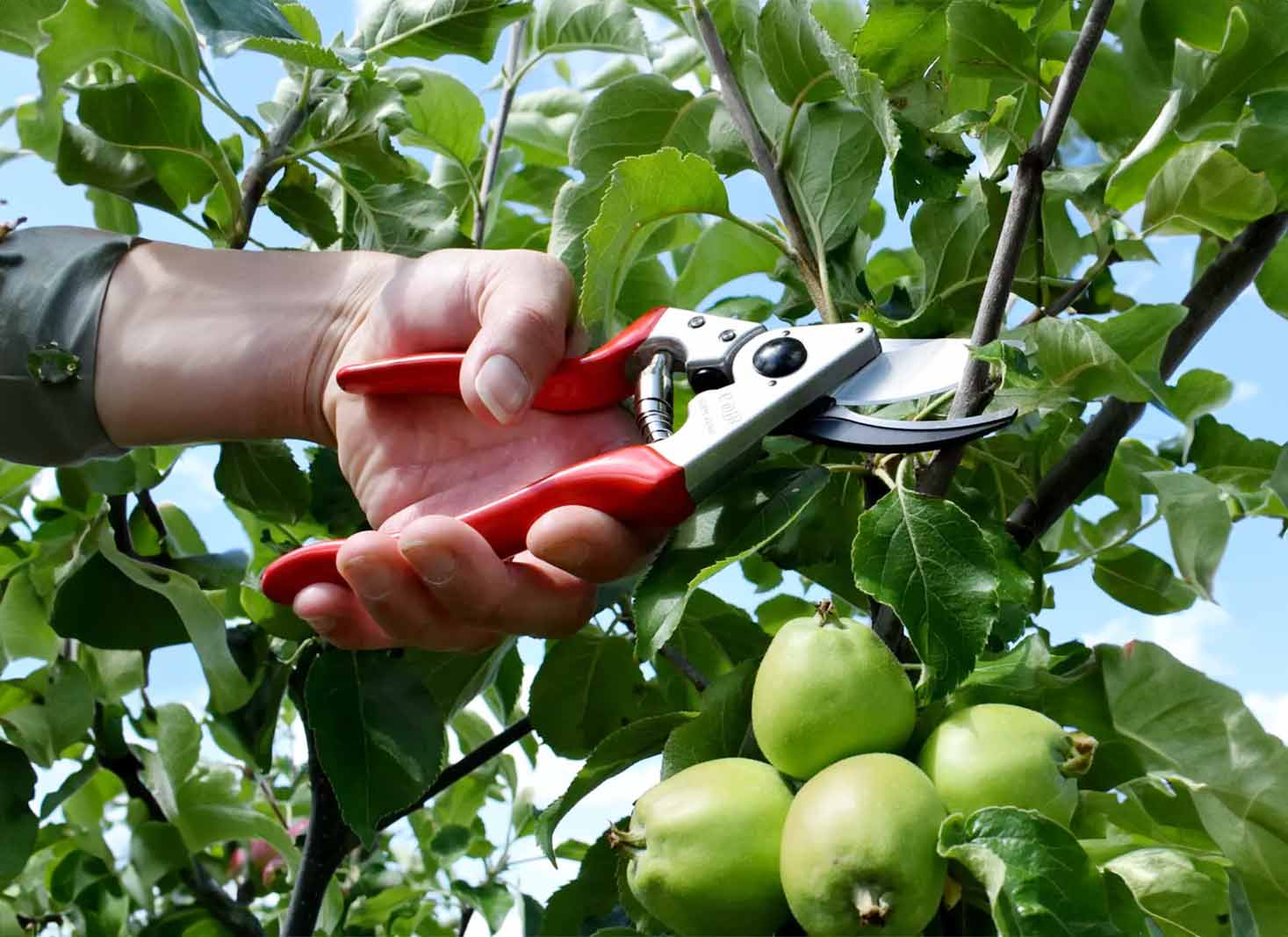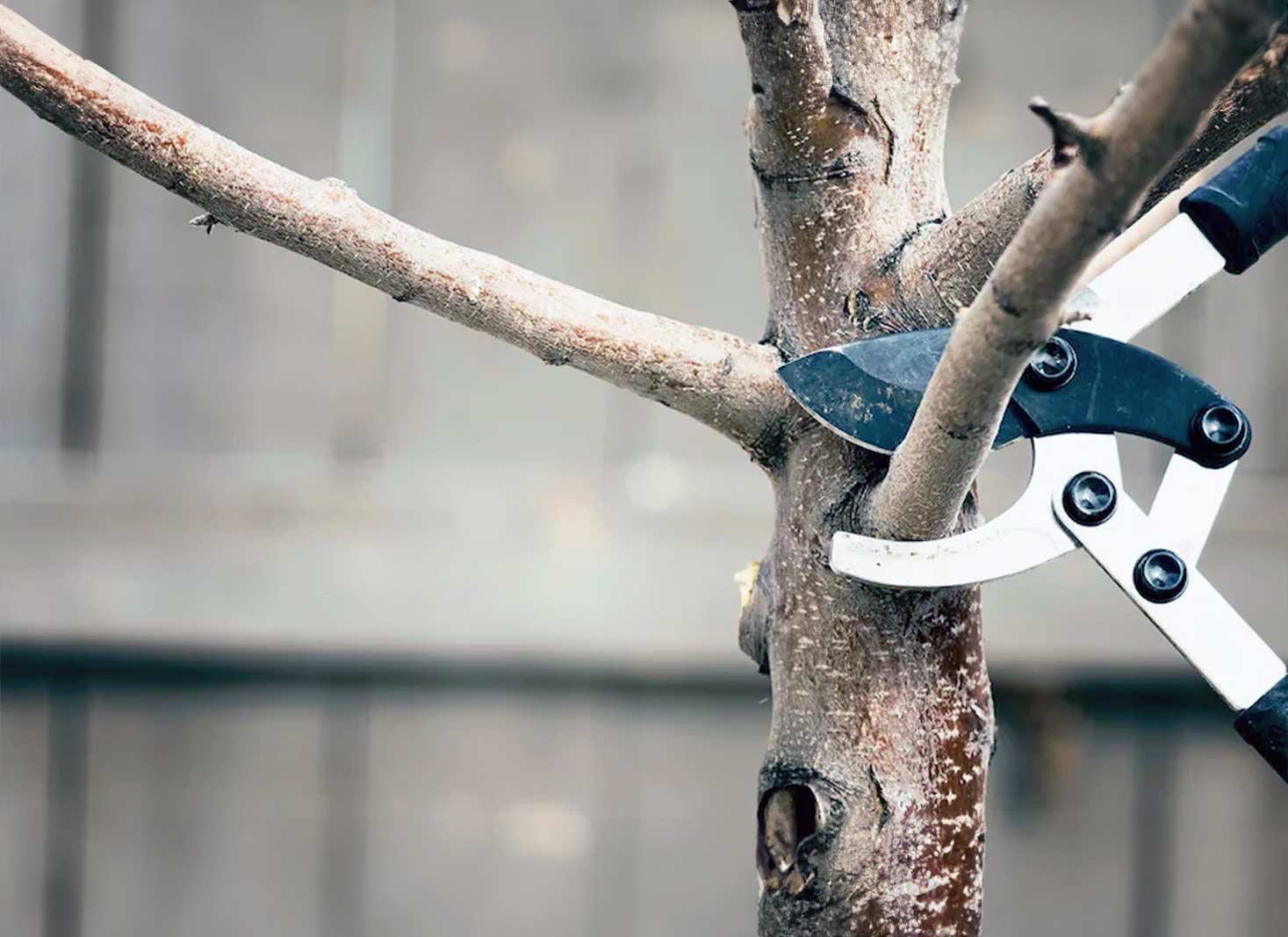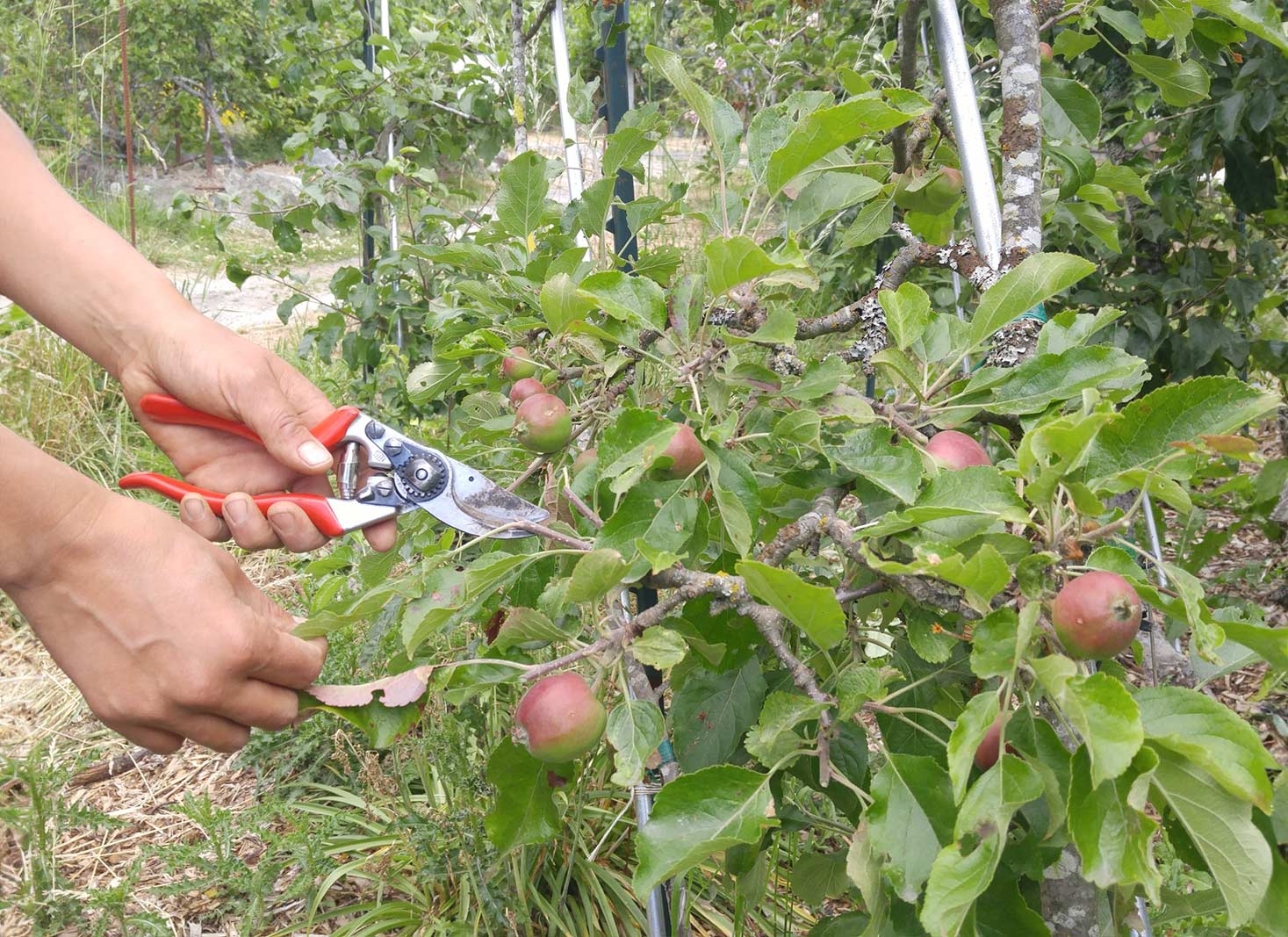Walk through your apple orchard on a fall day and admire the lovely trees, brimming with plump, ripe apples that are ready to be picked.
Understanding the anatomy and growth of apple trees is essential for successful pruning. Professional pruning tools should be kept clean and sharp, while late winter or early spring is the best time to prune.
Learn how to expertly trim branches as well as timing best practices when attempting to prune an apple tree.

What we cover
ToggleUnderstanding apple tree growth and fruit production
For optimal fruit production, apple trees and other fruit trees require proper pruning.
Understanding how the tree grows and produces fruits is necessary for effective cutting of branches to encourage stronger growth from residual buds which leads to a healthier tree in general.
By properly trimming apple trees it can help achieve their fullest potential by stimulating robustness from remaining tissues thereby increasing the yield of quality produce.
Apple tree anatomy
Knowing the anatomy of an apple tree is important in order to properly prune it. It consists of roots, a trunk, branches with buds, and spurs from which fruit can grow.
Spurs are short sections on the branch that carry fruits while buds act as shoots where new blossoms or limbs may sprout.
Tree parts such as these must be taken into consideration when one plans to trim back their apple trees so they will produce quality yields.
Fruit production process
Apple trees need regular fruit thinning for their health and the quality of fruits produced.
Most apple tree species naturally self-thin around June, making it an ideal time to intervene with the manual removal of any excess buds or clusters on a tree’s branches.
Flowering buds that will eventually develop into apples can be identified by their more rounded shape compared to vegetative growths and by being swollen at the base.
Thinning aims to create balance in yearly crop yields as well as ensure healthy fruit production overall.

Pruning basics: tools and timing
In order to prune your apple trees in an effective way, having the proper tools and knowing when is the best time for it is essential.
Here we will explain which specific tools you need for successful pruning as well as help guide you on how to recognize when it’s most optimal timing-wise.
Essential pruning tools
For trimming apple trees, hand pruners and loppers are essential tools. It is vital to keep the blades clean and sharp for making precise cuts without harming the tree.
Before starting your task of pruning, dip both surfaces of your cutting equipment in isopropyl alcohol, then let them air dry to achieve disinfection as well.
Use a soft cloth that has been moistened with isopropyl alcohol on the saw blade before you start work.
Doing this will ensure an accurate cut while also preserving healthy conditions for fruit-bearing branches in our beloved apple trees!
When to prune apple trees
Pruning apple trees in late winter or early spring is an ideal time, since it gives the tree ample opportunity to recover from any pruning wounds before the start of the growing season.
It’s also beneficial during summertime, decreasing the chances of diseases and pests as well as helping improve fruit production. The tree will be properly taken care of when using either period for cutting away unnecessary branches.
Pruning techniques for healthy apple trees

To maintain the health, shape, and flavor of a tree, proper pruning techniques should be employed. Initially, this will involve taking out sick or dead branches to contain any potential disease spread.
Then suckers and water sprouts need to go in order for fruit quality enhancement purposes as well as reinforcing an optimal tree structure.
Pruning is essential for giving proper form with established trees needing more complex trimming compared to younger ones which require simpler methods like shortening limbs where necessary.
Removing dead and diseased branches
Removing dead, broken, and diseased branches from a tree is an essential step in pruning.
By taking away these parts of the plant that are potentially hazardous to its health, it can channel more energy towards creating healthy growth and generating fruit.
To guarantee successful healing after cutting back undesired portions of a tree’s structure, appropriately trim off the unnecessary sections above branch collars with accurate, precision cuts.
Eliminating suckers and water sprouts
In order to ensure the tree is healthy and productive in terms of fruit production, one must remove any suckers, whorls, or water sprouts that are present.
Water sprouts have a distinctive form as they originate from existing scaffold branches but grow up towards the sky instead. These extra growths sap energy away from the tree itself, which can prove detrimental to its overall health.
Pruning for optimal tree structure
When it comes to apple tree maintenance, pruning can be a great way of achieving an optimally structured and shaped specimen.
Through the removal of dead or diseased branches, as well as cutting out suckers and water sprouts along with thinning fruiting spurs, you are essentially creating good air circulation throughout your tree for increased sunlight penetration.
This will ultimately lead to better health within the tree overall so that its productivity is not hindered in any way. In other words, maintaining a strong structure on your trees now leads to brighter prospects later down the line!
Shaping your apple tree: central leader vs. modified central leader
Apple trees come in two varieties. The central leader and a modified form of it. In this article, we will compare each tree shape’s pruning methods to help you decide which is best for your own apple tree.
Tree shapes have an important influence on how they should be cared for, so understanding both options before making a decision can prove beneficial.
The central leader style has its roots (pun intended!) in traditional orchard-style planting that employs tall single stems.
Central leader system
The central leader system of a tree can be easily identified because it forms the shape of an upright pyramid, with one stem at its peak.
This structure is much more stable and allows air to circulate well throughout while also allowing ample sunlight penetration, two qualities that help prevent wind breakage or damage to the branches.
To maintain this form when pruning, ensure that your tallest point (the “central leader”) stays intact, then cut lateral branches accordingly around it.
Modified central leader system
The modified central leader system is a suitable pruning technique for trees of moderate size with good fruit yield.
To ensure successful results, any branches that are dead or diseased need to be removed and unwanted suckers and water sprouts must also go.
Trimming down the fruiting spurs should help achieve desired outcomes as well. This variation from traditional approaches gives greater freedom in how one shapes their tree’s form while still ensuring satisfactory outputs.
Pruning young apple trees: establishing a strong foundation
Early pruning of apple trees is vital for building a sturdy base that will give them robust health and abundant yield.
This article covers the significance of pruning young apple trees, plus tips on how to promote their growth and fruit-bearing capability.
Pruned apple trees are bound to provide high yields while ensuring healthy development in future years!
Pruning bare root and potted trees
When planting a bare root apple tree, the branches and central leader should be cut back to reduce their length by half. On young potted trees, it’s recommended to achieve similar pruning results for optimal growth.
Newly planted bare-root trees are pre-pruned professionally so no pruning is required. Pruning is necessary at that time.
Developing scaffold branches
When caring for young apple trees, the growth of strong scaffold branches is necessary. These are key to upholding a stable canopy and ensuring future fruit production.
To create them, locate shoots that have about 4-6 inches between each one and appear more spread out than towering upwards away from the trunk.
Make sure these leads all point in different directions before pruning back any other leading branches except for just one main upward-growing branch remaining untouched.
Maintaining mature apple trees: pruning for fruit quality
Mature apple trees require regular pruning in order to ensure optimum fruit quality and maintain healthy growth. Pruning also helps reduce any potential risks associated with the tree’s health.
By doing so, you will be able to create a stronger foundation for future harvests of high-quality apples from your mature apple tree.
Pruning is an important part of managing older orchard trees, it contributes significantly towards sustaining good condition and encourages strong yields of superb fruits each season.
Make sure that the trimming techniques are carried out regularly as this ensures healthier branches produce abundant crops!
Thinning fruiting spurs
To encourage healthy growth and the production of larger, high-quality apples, thinning fruiting spurs is a necessary practice for mature apple trees.
Cut back existing spurs to their buds in order to stimulate new side shoots and promote growth. Spur development. It’s also beneficial during this process to take out any misshapen or defective fruits present as well.
Pruning for air circulation and sunlight penetration
In order to promote healthy and productive growth in an apple tree, airflow needs to be maximized and ample sunlight should penetrate the branches.
To achieve this goal, thinning out of the canopy as well as selective removal of certain limbs is necessary so that all parts of the tree receive adequate amounts of light.
This process will help eradicate potential sources for pests or diseases by ensuring there’s better circulation around it through its crown area.
Troubleshooting common apple tree pruning issues
Maintaining healthy and productive apple trees is a priority for every gardener, but mistakes during the pruning process can easily occur.
To avoid these errors, it’s important to know what not to do when caring for your tree. Namely, over-pruning or under-pruning as well as improper timing of prunes.
These blunders can be prevented if gardeners take care of the amount they are trimming from their trees and follow the correct season schedule when cutting branches back so that optimal growth may flourish.
Following these simple rules will ensure a successful outcome while nurturing those precious apple-producing saplings!
Over-pruning and under-pruning
Caring for an apple tree involves avoiding both over-pruning and under-pruning, which can have a detrimental effect on the health of the tree.
Excessive pruning depletes nutrients from it while inadequate trimming causes overcrowding and blocks air circulation around its branches.
To prevent this issue, limit how many limbs you remove to ensure sufficient nourishment is given as well as keeping up with regular thinning in order to maintain proper ventilation throughout your tree’s foliage.
Dealing with problem branches
Apple trees should be checked during late winter or early spring for any crossing, rubbing, damaged, or diseased branches.
Pruning tools such as hand pruners and loppers can then be used to make clean cuts beyond the branch collar in order to help ensure proper healing of the tree when removing these problematic limbs.
Be sure not to cut too close to avoid it. Issues with your apple tree’s health.
FAQ's
For optimal apple tree health and productivity, it is advisable to prune your trees in late winter or early spring once the cold has subsided but before buds appear.
This ensures wounds close quickly during the active growth period with clear visibility of their structure. On the contrary, avoid cutting them back in fall or early winter.
Pruning at this time will benefit from an increased healing rate while offering a great view of how sturdy and strong your tree’s branches are!
To ensure the well-being of an apple tree and maximize its potential, pruning in a “Central Leader” fashion is essential.
This technique involves snipping off limbs that are growing too closely together or having a competition with the central leader limb.
Branches that have intersecting parts or unorthodox angles should be cut away as well. By employing these methods when trimming your apple tree, it can reach full strength while still flourishing healthily.
Tree health and fruit production can be seriously compromised when pruning an apple tree incorrectly, so it is important to take care of this process.
It’s wise not to cut away more than one-fifth of the total branches in a single year. If too much trimming is done at once, irreparable damage could result.



